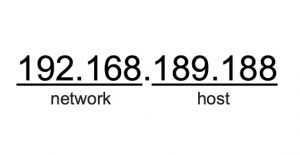Difference between revisions of "IP address"
| Line 1: | Line 1: | ||
[[File:Gateway firewall.svg|thumb|Gateway firewall]] | [[File:Gateway firewall.svg|thumb|Gateway firewall]] | ||
An [[Internet Protocol]] (IP) address is a unique | An [[Internet Protocol]] (IP) address is a unique combination of digits that identifies machines within an interconnected network. They are automatically assigned by routers when devices connect to a network. | ||
IPs are made up of strings of numbers separated by periods. Each number in the set can range from 0 to 255. So, the full IP addressing range goes from 0.0.0.0 to 255.255.255.255. | Most IPs (from Internet Protocol version 4) are made up of strings of numbers separated by periods. Each number in the set can range from 0 to 255. So, the full IP addressing range goes from 0.0.0.0 to 255.255.255.255. | ||
Every device that connects to your internet network has a local | IP addresses are local (private), or public. Every device that connects to your internet network has a local IP address. This includes computers, smartphones, and tablets but also any Bluetooth-enabled devices like speakers, printers, or smart TVs. A firewall separates your local network from the outside, so only devices connected to the same local network can inter-connect. | ||
Local IP addresses are on the [[LAN: Local Area Network|LAN]], or Local Area Network, and public IP addresses are on the [[WAN: Wide Area Network|WAN]], or Wide area Network. | Local IP addresses are on the [[LAN: Local Area Network|LAN]], or Local Area Network, and public IP addresses are on the [[WAN: Wide Area Network|WAN]], or Wide area Network. | ||
Every IP address is composed of a network component and a host component: | |||
[[File:IP_breakdown.jpg|300px|frameless|The components of an IP address]] | |||
[[Category: Glossary]] | [[Category: Glossary]] | ||
Revision as of 16:23, 7 October 2021
An Internet Protocol (IP) address is a unique combination of digits that identifies machines within an interconnected network. They are automatically assigned by routers when devices connect to a network.
Most IPs (from Internet Protocol version 4) are made up of strings of numbers separated by periods. Each number in the set can range from 0 to 255. So, the full IP addressing range goes from 0.0.0.0 to 255.255.255.255.
IP addresses are local (private), or public. Every device that connects to your internet network has a local IP address. This includes computers, smartphones, and tablets but also any Bluetooth-enabled devices like speakers, printers, or smart TVs. A firewall separates your local network from the outside, so only devices connected to the same local network can inter-connect.
Local IP addresses are on the LAN, or Local Area Network, and public IP addresses are on the WAN, or Wide area Network.
Every IP address is composed of a network component and a host component:

